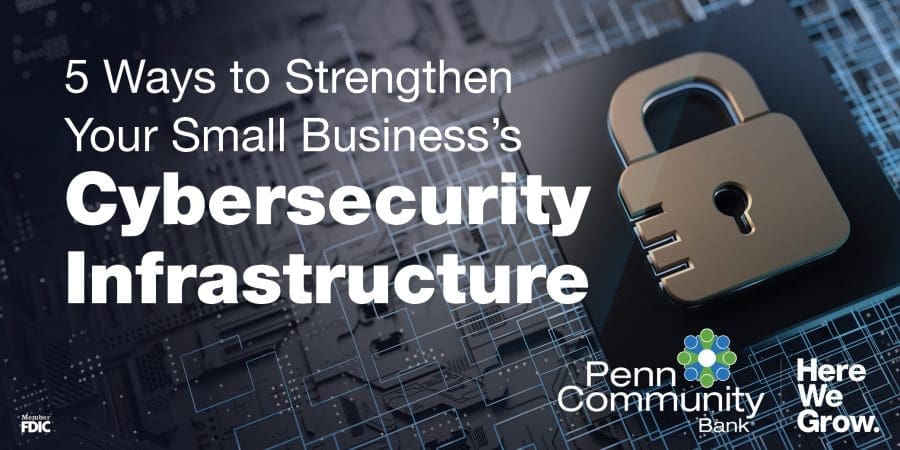
As technology continues to advance and we increasingly rely on digital transformation, cybercriminals forge on with new ways to capitalize on unsuspecting victims’ private information. Cyberattacks are at an all-time high, and it is essential for businesses to take a critical look at their cybersecurity plans so they can safeguard their proprietary data and their customers’ personal information.
In addition to protecting your financial information, at Penn Community Bank we believe knowledge is power. Below are five steps you can take to ensure your cybersecurity plan incorporates some of today’s best practices for businesses:
- Implement firewalls for home- and office use. When your devices — including tablets, laptops, desktop computers, and phones — are accessible through a Wi-Fi network or internet connection, they may be susceptible to a cyberattack. One best practice to restrict unwanted access to your devices, and the information that they house, is by installing a firewall. Firewalls can shield your device or network from malicious or unnecessary network traffic, as well as prevent malware from accessing a computer or network via the internet. Using a firewall alongside other protective measures can strengthen your ability to ward off cyberattacks.
- Protect your accounts with multifactor authentication, when available. Business email compromises are big business for cybercriminals. Once a fraudster gains access to your device, they often watch how you conduct your business online. In many cases, the criminal will send emails using your account to your unsuspecting vendors or your financial institution looking to wire funds to their accounts. Using multifactor authentication can make it much more difficult for cybercriminals to hack your account.
- Be wary of coronavirus financial relief scams. Many of our small-businesses clients have reported that they have received unsolicited phone calls or emails from people who claim to have an inside track to expedite financial relief. In many of these situations, the fraudsters who contact them will charge upfront fees or ask the business to provide sensitive financial information, such as account numbers, tax IDs, and Social Security numbers. Do not take the bait: Applying for loans is a formulaic and step-by-step process, and any solicitation providing a quick fix for financial relief is a scam.
- Choose your passwords wisely. The passwords that you use to access your email, banking platform, online retailer, or any other account should be confidential and strong. A solid password will be difficult for someone else to guess, unique to each platform and not reused for multiple accounts, avoid using words commonly found in a dictionary, and use the maximum number of characters that each password system allows. In addition, the strongest passwords will include uppercase letters, lowercase letters, numbers, and special characters, if the platform allows.
- Reduce your risk of malware infection. Cybercriminals often use malware — such as spyware or viruses — to gain access to your computer for monitoring purposes, steal your personal information, and control your device. In most cases, the fraudsters coerce unsuspecting people to click on links that result in an automatic download. To avoid malware, be sure to keep your devices’ security software and browser security settings up to date, and do not click on suspicious links within emails. Additionally, do not open any email attachments from unknown sources.
Educating yourself about different forms of attacks can also help you protect your personal information. Whether you are composing an email, responding to a text message, logging into a social media account, or accessing an automated teller machine, take the time to THINK:
Trace the source of the communication or platform to ensure it is legitimate.
Hide your credentials by keeping usernames and passwords confidential.
Intelligently use online forums, especially when logging onto public networks.
Notify the proper authorities and businesses IMMEDIATELY after identity theft.
Know your cyber footprint and the risk profile it entails.


